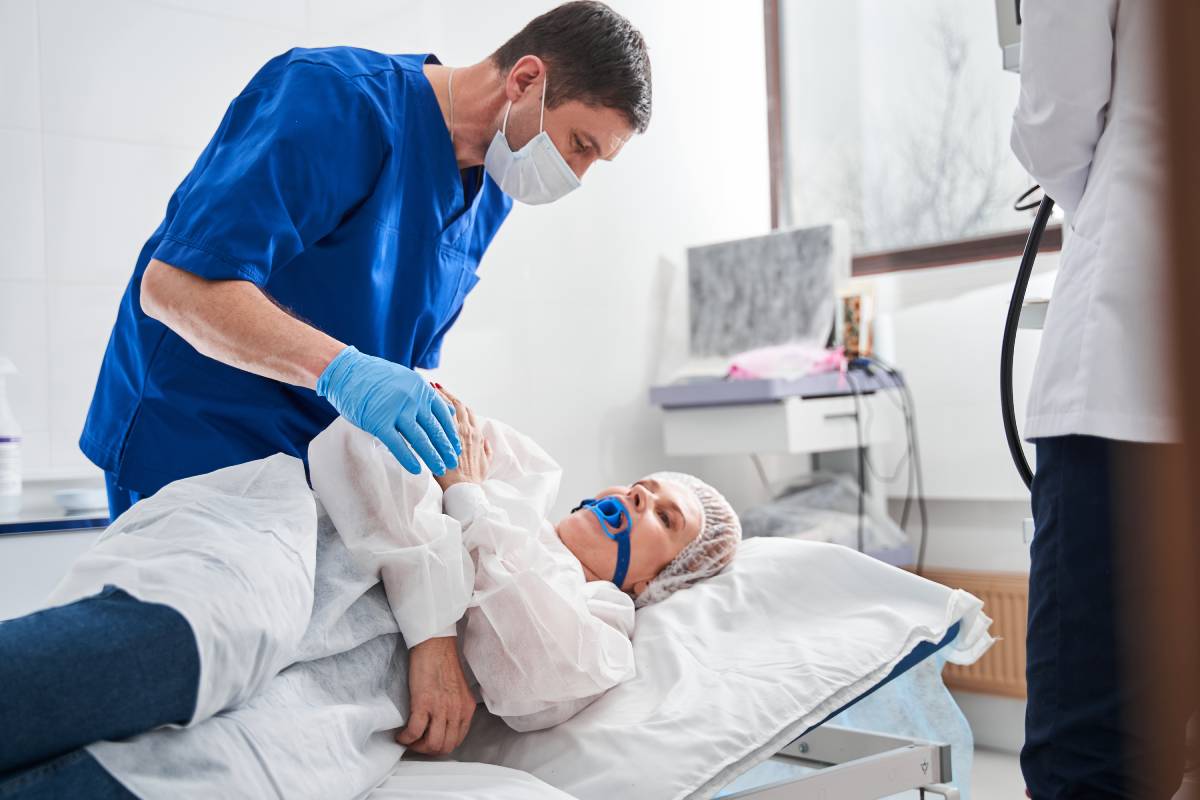Increased Patient Satisfaction after Endoscopy with Sedation

In the United States, most routine gastrointestinal endoscopic procedures are performed with some form of sedation [1]. Endoscopy, which includes colonoscopy and esophagogastroduodenoscopy (EGD), is an uncomfortable procedure and can often cause abdominal pain, cramping, bloating, gagging, retching, and choking [2]. Using sedation for endoscopy not only allows for relaxation and an easier procedure, but also increases patient satisfaction with the procedure and outcome.
Different forms and levels of sedation exist. Per the American Society of Anesthesiology (ASA) there is minimal, moderate, and deep sedation, as well as general anesthesia [4]. For endoscopic procedures, moderate sedation, in which the patient continues to be conscious and breathe on their own, is sufficient for endoscopy. Deep sedation with monitored anesthesia care and possible airway support can also be used. In rare cases, depending on patient comorbidities and complexity of the procedure, general anesthesia may be used with airway intubation. With moderate sedation, a variety of medications may be used, including benzodiazepines, opiates, and propofol. Agents such as midazolam, diazepam, pethidine, fentanyl, remifentanil, or meperidine are most typical. Midazolam and fentanyl have been found to be the most effective for endoscopy and have low cardiopulmonary complication rates [5].
Patient satisfaction is an important outcome measure for procedures such as endoscopy, which is both a common diagnostic procedure and preventative procedure for colorectal cancer screening, and thus should be considered when deciding whether to provide sedation. Patients who are satisfied with care are more likely to comply with medical services and providers [6]. Studies have shown that conscious sedation endoscopy not only improves patient satisfaction, but also reduces fear and discomfort and improves compliance with repeat endoscopic procedures [3,7].
As sedated endoscopy has become more commonplace in clinical medicine, the quality of sedation becomes an important factor in patient outcomes. Midazolam, as aforementioned, has become the most widely used drug for endoscopy sedation. A recent study found that over 80% of all patients undergoing EGDs with midazolam sedation were satisfied with their experience [7]. Factors that influenced decreased patient satisfaction were procedure-related factors rather than sedation-related. In a similar study, patient satisfaction with endoscopic procedures was associated with the manner of endoscopy unit staff, length of time that staff devoted to explaining the procedure, environment of the endoscopy suite, and pain control during the procedure [6]. Thus, areas for improvement in endoscopy should be centered around the procedure itself and the environment. This includes inter-procedure waiting times, if a patient is undergoing a same day EGD and colonoscopy, and overall length of procedure time.
Overall, there are high patient satisfaction rates with endoscopy with sedation and facilities should continue to focus on patient comfort by improving procedure wait times as well as environmental factors including patient comfort and staff mannerisms.
References
- Lin, Otto S. “Sedation for Routine Gastrointestinal Endoscopic Procedures: A Review on Efficacy, Safety, Efficiency, Cost and Satisfaction.” Intestinal Research, vol. 15, no. 4, 2017, p. 456, dx.doi.org/10.5217%2Fir.2017.15.4.456, 10.5217/ir.2017.15.4.456.
- Ghanouni, Alex, et al. “Patients’ Experience of Colonoscopy in the English Bowel Cancer Screening Programme.” Endoscopy, vol. 48, no. 03, 3 Feb. 2016, pp. 232–240, 10.1055/s-0042-100613.
- Cohen, Lawrence B., et al. “Endoscopic Sedation in the United States: Results from a Nationwide Survey.” The American Journal of Gastroenterology, vol. 101, no. 5, May 2006, pp. 967–974, 10.1111/j.1572-0241.2006.00500.x.
- Gross, Jeffrey B, et al. “Practice Guidelines for the Perioperative Management of Patients with Obstructive Sleep Apnea.” Anesthesiology, vol. 104, no. 5, May 2006, pp. 1081–1093, 10.1097/00000542-200605000-00026.
- McQuaid, Kenneth R., and Loren Laine. “A Systematic Review and Meta-Analysis of Randomized, Controlled Trials of Moderate Sedation for Routine Endoscopic Procedures.” Gastrointestinal Endoscopy, vol. 67, no. 6, May 2008, pp. 910–923, 10.1016/j.gie.2007.12.046.
- Loftus, Russell, et al. “Patient Satisfaction with the Endoscopy Experience and Willingness to Return in a Central Canadian Health Region.” Canadian Journal of Gastroenterology, vol. 27, no. 5, 2013, pp. 259–266, 10.1155/2013/615206.
- Jin, Eun Hyo, et al. “How to Improve Patient Satisfaction during Midazolam Sedation for Gastrointestinal Endoscopy?” World Journal of Gastroenterology, vol. 23, no. 6, 2017, p. 1098, 10.3748/wjg.v23.i6.1098.